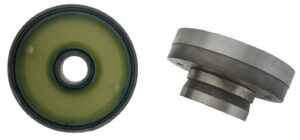Our Top 5 Specialty Uses of Urethane
When it comes to material versatility, polyurethane has emerged as the decisive victor over metals and plastics of all kinds in just the past half a century. From flexible shock absorbers to rigid protective liners, there’s no other material that can match the uses of urethane.
With such a broad range of potential properties, the applications of urethane products are close to limitless. In fact, there are some specialty urethane formulations suited for applications that you may have never considered before. Follow along as we list out our top 5 specialty applications for polyurethane products- all of which we can produce here at PSI Urethanes.
1. Bonded Urethanes

At the top of our list we have bonded urethanes. What lands bonded urethanes at the top spot is that they can encompass all different polyurethane formulations with different durometers, deflection, and so forth. What makes these urethanes so special is that they are physically bonded to another substance, often metal or other polymers.
Now, why would somebody want a bonded urethane part? In many cases, the base material or ‘core’ will have a given set of properties that make it ideal for the application at hand.
For example, a roller for a conveyor machine may use a metal core that can withstand the daily wear of a production line. However, if the roller was made entirely of metal, it could impart defects onto the parts that are being moved in the form of scrapes, scratches, or flakes that can become dangerous contaminants. Not to mention, a solid metal roller would be highly inefficient due to its weight and cost.
For a roller that won’t damage product and has the ideal coefficient of friction for conveying product, a bonded urethane roller presents an idea solution. The inner core can maintain the strength of the metal base, while the outer urethane portion can safely and efficiently keep product moving along the conveyor line.
Some common uses of urethane where bonding can be beneficial include rollers, bushings, lined pipes, and flexible fluid cell bladders for sheet hydroforming machines.
2. Dual Durometer Urethanes
Coming in hot at number 2, we have dual durometer urethanes. Similar to bonded urethanes, dual or multi-durometers will give you the best of both worlds. The difference is that these parts are made of solid urethane all the way through, making them a great choice for uses where a low total weight is important.
While bonded urethanes are limited by the restrictions of an existing core, dual durometer urethane products can take all forms including liners, sheets, and pads. So, if a flat piece of material needs to have certain properties on one side but different properties on the other, that can be achieved with a dual durometer urethane. We have a great example of this coming up later, so we’ll stick a pin in that idea for now.
Although the name “dual durometer” implies that there has to be a combination of two or more hardnesses, that’s not always the case. Sometimes the difference between layers can be purely cosmetic. This is usually what customers ask for when we manufacture dual durometer liners, which are used as wear indicators in highly abrasive applications. The two layers are made of highly contrasting colors, so when one layer is worn through, the next one will be clearly visible to show that it’s time for a new liner.
Dual durometer urethanes are one of our signature offerings. If you need the best of both worlds, get it from the best in the business.
3. Flame Retardant Urethanes

Keeping it cool at number 3 are flame retardant urethanes. Like with dual durometer, just about any kind of part can be made of a flame retardant urethane. The differentiators that define this type of urethane are two-fold: one part has to do with formulation, and the other part has to do with meeting performance metrics in a standardized test.
UL 94V-0, a method devised by Underwriters Laboratories (UL), is the most rigorous set of standards that a polyurethane product can be tested to in order to gain the flame retardant classification. In short, the material must be able to withstand sustained, direct contact with a flame for a certain amount of time in order to be classified as flame retardant. We won’t go into the full testing method here, but if you want to learn more about it you can check out our video where we perform the test on one of our own products.
Flame retardant urethanes are critical for cases where the finished part will be exposed to high temperatures, flammable chemicals, or a combination of both. These parts can act as an initial failsafe to slow the spread of a fire, giving both manufacturers and end users the chance to fully extinguish a flame before it gets out of hand.
4. Static Dissipative Urethanes
Don’t be shocked to find out that static dissipative urethanes are coming in at number 4 on our list. Like flame retardant urethanes, static dissipative formulations are one of the more particular uses of urethane. When the right circumstances do present themselves, there’s no better material for the job.
As a polymer, urethane is generally an insulative material. However, static dissipative formulations can imbue the material with just enough electrical conductivity to prevent a buildup of unwanted charge. This makes it ideal for cases where the part will experience repeated sliding abrasion or similar motions which are known to cause a static charge to accumulate.
There are a number of different formulations and additives that can be used to achieve this, but there is one that stands leagues above the rest- and that’s the addition of carbon nanotubes. Regarded throughout the materials engineering community as the strongest material on earth, carbon nanotubes not only possess great tensile strength but also serve as excellent electrical conductors. By mixing a small amount of carbon nanotubes into a urethane formula, the final parts can exhibit a level of conductivity that classifies them as static dissipative.
5. Urethane Spill Control Devices

We’ve potentially saved the best for last. At number 5 we have urethane spill control devices, a staple offering here at PSI Urethanes. Remember that pin we stuck in the dual durometer section earlier? This is where it comes back into play.
In chemical laboratories and testing facilities, one wrong spill can spell disaster. That’s why we fully utilize the chemical resistance and flexibility of polyurethanes to make the most effective drain protector seals around.
For small holes and round drain openings, we offer a variety of conical drain plugs that create a watertight seal to keep unwanted liquids out. But not all drains are small or round, so what then? That’s where our trademarked DrainProtector shines. The Original DrainProtector is a flexible, dual durometer sheet that is designed to maximize seal security. The orange side has a low durometer which facilitates maximum adhesion with the surface around the drain. The yellow side is still flexible, but is less tacky for higher chemical resistance and easy handling. With contrasting colors to indicate the right and wrong sides, correct application is always quick and easy.
That closes out our list of top 5 specialty uses of urethane. To learn more about whether a specific formulation is right for you, give us a call or contact PSI Urethanes through our online form.
No matter how specialized your application may be, we’re confident that we can engineer a polyurethane solution that exceeds your expectations. Find out more about the potential uses of urethane today.



